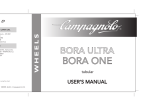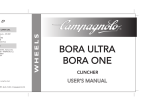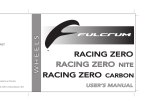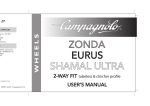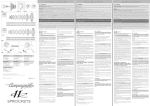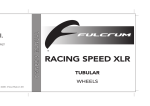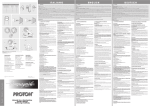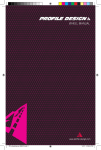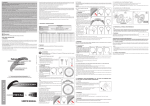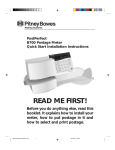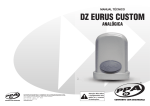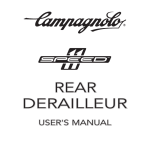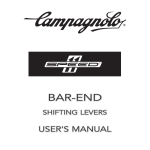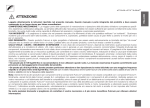Download User manual Zonda 2-way- fit wheels
Transcript
D aka-ku - 231-0041 N 2780 30 agnolo.jp D 0th Rd., Nantue Dist. 08 - TAIWAN (R.O.C.) 06831 764 WHEELS O JAPAN LTD. ZONDA EURUS SHAMAL ULTRA 2-WAY FIT tubeless & clincher profile or using the wheel. 7269555 - 04/2015 - © Campagnolo S.r.l. 2015 USER’S MANUAL WARNING! ENGLISH Carefully read, follow and understand the instructions given in this manual. It is an essential part of the product, and you should keep it in a safe place for future reference. MECHANIC QUALIFICATION - Please be advised that many bicycle service and repair tasks require specialized knowledge, tools and experience. General mechanical aptitude may not be sufficient to properly service or repair your bicycle. If you have any doubt whatsoever regarding your service/repair ability, please take your bicycle to a qualified repair shop. INTENDED USE - This Campagnolo® product is designed and manufactured for use only on road racing style bicycles that are ridden only on smooth road or track surfaces. Any other use of this product, such as off-road or on trails is forbidden. "AN ACCIDENT" - Please note that throughout this manual, reference is made that "an accident" could occur. Any accident could result in damage to your bicycle, its components and, more importantly, could cause you or a bystander to sustain severe personal injury or even death. LIFESPAN - WEAR - INSPECTION REQUIREMENT - The lifespan of Campagnolo® components depends on many factors, such as rider size and riding conditions. Impacts, falls, improper use or harsh use in general may compromise the structural integrity of the components and significantly reduce their lifespan. Some components are also subject to wear over time. Please have your bicycle and its components regularly inspected by a qualified mechanic for any cracks, deformation, signs of fatigue or wear (use of penetrating fluid or other visual enhancers to locate cracks on parts is recommended). Disassembly your bicycle components and especially the pedals, is required during these inspections. If the inspection reveals any deformation, cracks, impact marks or stress marks, no matter how slight, immediately replace the component; components that have experienced excessive wear also need immediate replacement. The frequency of inspection depends on many factors; check with your authorized representative of Campagnolo S.r.l. to select a schedule that is best for you. • If you weigh over 109 kg/240 lbs we advise you not to use this product. Non compliance with this warning can damage the product irreversibly. • If you weigh 82 kg/180 lbs or more, you must be especially vigilant and have your bicycle inspected more frequently (than someone weighing less than 82 kg/180 lbs). Check with your mechanic to discuss whether the wheels you selected are suitable for your use, and to determine the frequency of inspections. The components of Campagnolo® 9s, 10s and 11s transmissions, as well as the brakes, rims, pedals and all other Campagnolo® products are designed as a single integrated system. Not to affect safety, perforWmance, longevity, functionality and the WARRANTY, use exclusively the parts and components supplied or specified by Campagnolo S.r.l., without interfacing or replacing them with products, parts or components manufactured by other companies. Note: Tools supplied by other manufacturers for wheels similar to Campagnolo® wheels may not be compatible with Campagnolo® wheels. Likewise, tools supplied by Campagnolo Wheels S.r.l. may not be compatible with components/wheels supplied by other manufacturers. Always check with your mechanic or the tool manufacturer to insure compatibility before using tools supplied by one manufacturer on components/wheels supplied by another. The user of these Campagnolo® wheels expressly recognizes that there are risks inherent in bicycle riding, including but not limited to the risk that a component of the bicycle can fail, resulting in an accident, personal injury or death. By his purchase and use of these Campagnolo® wheels, the user expressly, voluntarily and knowingly accepts and/or assumes these risks, including but not limited to the risk of passive or active neglicence of Campagnolo S.r.l. or hidden, latent or obvious defects in the product, and agrees to hold of Campagnolo S.r.l. harmless to the fullest extent permitted by law against any resulting damages. If you ever have any questions, please contact your mechanic or your nearest Campagnolo® dealer for additional information. Please note that throughout this manual, reference is made that an accident could occur. Please note that any accident can result in damage to your bicycle and, more importantly, personal injury or, death to you or a bystander. Always follow all warnings and instructions in this manual. 1 SAFETY RECOMMENDATIONS WARNING! ENGLISH Always wear protective gloves and glasses while working on the wheels. DO NOT RIDE YOUR BICYCLE IF IT DOES NOT PASS THIS PRE-RIDE TEST. CORRECT ANY CONDITION BEFORE YOU RIDE! • Never use a bicycle or bicycle component unless you are thoroughly familiar with its use and maintenance history. “Used” equipment may have been misused and abused, and can unexpectedly fail resulting in an accident. • Be sure that your wheels are perfectly centered. Spin the wheels to be sure that they do not wobble up and down or from side to side, and that they do not make contact with the brake pads while rotating. • Be sure that all of the components of your bicycle, including but not limited to your brakes, pedals, handgrips, handlebars, frame and seating system, are in optimum condition and suitable for use. • Be sure that none of the components of bicycle are bent, damaged or out of alignment. • Check to be sure that all quick release fasteners, nuts and bolts are properly adjusted (see the “Quick Release” instruction sheet). Bounce the bicycle on the ground and listen and look for anything which may be loose. • Be sure that your wheels are perfectly centred. Spin the wheels to be sure that they do not wobble up and down or from side to side, and that they do not make contact with the fork legs or brake pads while rotating. • Check all reflectors to make sure that they are clean, straight and securely mounted. • Check you brake pads and cables to be sure they are in good condition. • Test your brakes in the beginning of your ride to make sure that they are operating properly. • Wear clothes which are snug-fitting and which make you visible to traffic, such as neon fluorescent or other bright colors. • Avoid biking at night, because it is more difficult for you to be seen by traffic, and it is more difficult for you to see obstructions on the ground. If you do ride at night, you should equip your bicycle with and use a headlight and a taillight. • Learn and follow the local bicycle laws and regulations, and obey all traffic signals, signs and laws while you ride. • Campagnolo s.r.l. reminds you to always wear a properly fitted and fastened bicycle helmet that has been approved by ANSI or SNELL. 2 1 - TECHNICAL SPECIFICATIONS RIM: 634 (622x15C) O.L.D.: front: 100 mm INFLATION PRESSURE: see the inflation pressure recommended by the producer of the tire. USE: road racing on smooth road or track surfaces only. ENGLISH 1.1 - WHEEL TECHNICAL SPECIFICATIONS rear: 130 mm 1.2 - SPOKES TECHNICAL SPECIFICATIONS WARNING! Only use genuine Campagnolo spokes for your specific type and model of wheel. Failure to use correct spokes can result in an accident, personal injury or death. WARNING! To correctly assess wheel tension a tensiometer must be used: do not go by the tension you feel manually. It is therefore essential to have all the spoke replacement operations carried out by a Campagnolo Pro-Shop, a Campagnolo Service Centre or a mechanic specialised in assembly and maintenance on Campagnolo wheels. The spoke part numbers can be found in the spare parts catalogue which is downloadable from our website www.campagnolo.com. 3 2 - TIRES ENGLISH 2-Way Fit rims are designed for both tubeless and standard clinchers. TYRE 2.1 - INSTALLING CLINCHER TIRES WARNING! RIM-TIRE COMPATIBILITY All Campagnolo rims are made with very precise dimensionally. If a tire is too easy to install on a Campagnolo rim, that tire is most likely too big and will not seat properly on the rim. If a tire is too difficult to install, that tire is most likely too small. Use only high quality tires that require the use of tire levers and a reasonable installation effort. Using talcum powder on the tire will make installation easier. Using a tire that does not fit properly on the rim can cause sudden and unexpected tire failure, resulting in an accident, personal injury or death. • Before fitting the tires, check that the diameter indicated on the tire is 622 and that the cross-section is between 23 and 28 mm, to insure that the tire and wheel are compatible. WARNING! Failure to properly install the tire can cause sudden and unexpected loss of tire pressure, resulting in an accident, personal injury or death. BEAD RIM 1 2 Be sure that you do not damage or otherwise bend any portion of the rim when installing the tire. Be careful not to damage or bend any part of the rim when mounting the tyre. Damaging the edge of the rim can compromise its operation, especially when using tubeless tyres. Check that the inside of the tyre and rim are perfectly clean; clean them with a cloth if necessary. WARNING: If you are unable to fit and remove the tyres by hand use plastic tyre levers (never use metallic levers because you could damage the rim and the tyre). • Fit the first bead of the tyre into the rim groove (Fig. 1) starting from the point opposite the valve. • Introduce a partially inflated presta inner tube into the tyre (Fig. 2). 4 • Fit the other bead of the tyre into the rim groove (Fig. 3) starting from the point opposite the valve, and continue around the whole circumference of the rim, taking care not to pinch the tube. • Wet the tyre bead and rim profile with soap and water. To deflate the tire: 1)remove the cap, 2) unscrew the valve, 3) press and hold down the valve to obtain the required pressure, then, ENGLISH 4) tighten the valve, 5) replace the cap. WARNING! Never exceed the maximum inflation pressure recommended by the tire manufacturer or for the cross section of the clincher tire you are using. Excessive tire pressure reduces grip on the road and increases the risk that the tire will unexpectedly burst. Inflation pressure that is too low reduces tire performance and increases the probability of sudden and unexpected loss of tire pressure. In addition, premature wear and damage to the rim may occur. 3 4 • Inflate the inner tube until the two tyre beads go into place correctly (Fig. 4). • Deflate the tyre completely and check the correct adherence of the bead around the whole rim. If the tyre is not fitted correctly the bead will separate from the tyre if deflated. • Inflate the tyre again and respect the working pressure. WARNING! Incorrect tire pressure could cause sudden and unexpected tire failure or loss of control of the bicycle, resulting in an accident, personal injury or death. • Screw back the valve ring. • Put back the valve cap. 5 2.2 - FITTING THE TUBELESS TYRE ENGLISH In order to properly and safely use Campagnolo rims, a perfect seal must exist between the rim and tire. While Campagnolo makes no representations about their performance or quality, and is not responsible for any possible failure of the tire. TO RECOGNIZE A TUBELESS TYRE, CHECK FOR THE TUBELESS WORDING OR LOGO. A A 2.2.1 - FITTING THE M1-102 TUBELESS VALVE Notes - The valve is supplied already fitted on the rim. - Periodically check the tightness of the valve and of the entire Tubeless system (see paragraph 2.6). We recommend changing the Tubeless valve once a year to optimize tightness. - Only use original Campagnolo M1-102 valves. - Tighten the valve ring (A – Fig. 5) by hand only. 5 2.2.2 - FITTING THE TUBELESS TYRE WARNING! Carefully follow the instructions provided by the tubeless tyre manufacturer. • Check that the inside of the tyre and rim are perfectly clean; clean them with a cloth if necessary. • Thoroughly wet the tyre bead with a dampened sponge or with a moistener placed (Fig. 6). 6 6 • Fit the first bead of the tyre into the rim groove (Fig. 7) starting from the point opposite the valve. A NOTE TO PREVENT DAMAGING THE TYRE IT IS NECESSARY TO COMPLETE THE INSERTION OF ITS BEAD EXACTLY IN CORRESPONDENCE WITH THE VALVE (FIG.10). • Check that the tyre is positioned correctly on both sides of the valve zone (Fig. 10). ENGLISH • Bend the tyre to fit the second bead into the groove on the rim (Fig. 8) starting on the part opposite the valve and continuing along the rim’s entire circumference (Fig. 9). D B C 7 8 A - TYRE B - WHEEL RIM C - GROOVE D - BEAD 9 10 7 • Wet the tyre bead and rim profile with soap and water (Fig. 11) using a brush. ENGLISH • Inflate the tyre to the working pressure shown on the tyre until the two beads engage with the rim (Fig. 12). Deflate the tyre almost completely (Fig. 13) and inspect the tyre by pressing lightly with your fingers along the entire circumference to make sure the bead is perfectly inserted. If the tyre is not properly mounted the bead will come out of its housing on the rim. • Inflate the tyre to the pressure marked on the tyre wall. Make sure the tyre shows a regular shape all along its circumference. 11 12 • Close the lock ring with your fingers (C - Fig. 14). • Screw back the valve ring (C - Fig. 14) • Put back the valve cap (B - Fig. 14). C B 13 8 14 2.3 - HOW TO REPAIR A PUNCTURE WARNING! • Change the tyre immediately if it is punctured, even minimally. A damaged tyre could explode, even suddenly, and cause accidents, physical injury or death. ENGLISH E • NEVER use pierce-resistant sealers containing alkaline substances (ammonia - sodium hydroxide). D How to check for air leaks? If anomalous pressure losses occur, check: - the tyre bead surface C - the outer surface of the tyre (tread and sidewalls); - the surface of the bead housing on the rim. B - Make sure the extension (Fig. 15 - D) is firmly screwed onto the rim by the ring (Fig. 15 - E). - Make sure the valve (Fig. 15 - C) is firmly screwed onto the extension (Fig. 15 - D). 15 We recommend that you do not inflate your TUBELESS tyres to a pressure below 6 bar: if they are not inflated sufficiently there is a risk that the bead will separate slightly from their seat and cause small air leaks. Remember that you must always check the tyre inflation pressure before you use them every time. 9 2.4 - WHEN YOU USE TUBES ENGLISH Notes Check that the tube valve is compatible with the rim. If it is not, contact the nearest dealer to receive more precise information on compatible tubes. - THE USE OF RIM TAPE IS NOT REQUIRED. • Deflate the tyre. • Unscrew the valve ring (A - Fig. 16) by hand and remove the valve. • Introduce a partially inflated presta inner tube into the tyre (Fig. 17). • Fit the other bead of the tyre into the rim groove (Fig. 18) starting from the point opposite the valve, and continue around the whole circumference of the rim, taking care not to pinch the tube. • Wet the tyre bead and rim profile with soap and water. • Inflate the inner tube until the two tyre beads go into place correctly (Fig. 19). • Deflate the tyre completely and check the correct adherence of the bead around the whole rim. If the tyre is not fitted correctly the bead will separate from the tyre if deflated. • Inflate the tyre again and respect the working pressure. A 16 17 18 19 • Screw back the valve ring • Put back the valve cap WARNING! Also when using an inner tube, proper coupling is absolutely necessary to maintain the tire or the rim and avoid personal injury or death. 10 2.5 - REMOVING THE TUBELESS TYRE WARNING! ENGLISH Carefully follow the instructions provided by the tubeless tyre manufacturer. • Deflate the tyre. • Starting from the point opposite the valve, press one side of the tyre with your hands until you uncouple the bead from its seat (Fig. 20), making it drop into the rim groove (Fig. 21). Continue around the whole wheel circumference (Fig. 22). 20 • Starting from the valve, pull the tyre with your hands until it comes out of the rim (Fig. 23). Continue around the whole wheel circumference. 22 21 23 11 • Carry out the same operations on the other side of the tyre (Fig. 24 and 25). Note ENGLISH Completely remove one side of the tyre before going on to the other side. • Lift off the tyre (Fig. 26). 24 25 26 2.6 - CHECKING THE TIGHTNESS OF THE TUBELESS SYSTEM (TUBELESS RIM + TUBELESS TYRE) • Check that the tyre and rim are in good condition. • Check that the inside of the tyre and rim are perfectly clean; clean them with a cloth if necessary. • Inflate the tyre to the working pressure and immerse the wheel with its tyre in a basin of water to check for cuts or punctures. Replace the tyre if necessary. • If the leakage occurs in the valve zone, check: - that the valve is screwed onto the adapter properly. - that the ring is securely tightened. If the leakage persists, replace both of them If the leakage occurs between the bead and the edge of the rim, disassemble the tyre, make sure that there are no cuts or punctures and repeat assembly. If after all these checks the tightness of the Tubeless system is still not satisfactory, contact your nearest Campagnolo dealer. 12 3 - FITTING THE WHEEL ON THE FRAME / USING THE QUICK RELEASE See the “Quick Release” instruction sheet. ENGLISH 4 - SPROCKET ASSEMBLY AND REMOVAL 4.1 - 10s SPROCKETS Refer to the instruction leaflet enclosed with the 10s sprockets for all the assembly, disassembly, use and maintenance operations. 4.2 - 11s SPROCKETS of Campagnolo s.r.l. (on FW body for 11s sprockets of Campagnolo s.r.l. ) 4.2.1 - ASSEMBLY 1) The sprockets are pre-assembled and timed on the plastic support (A - Fig. 27). The ring G (Fig. 27) is provided with a preassembled washer (H); ensure that it is positioned as in fig. 27.1. G G 2) Remove the ring (G - Fig.27). 3) Insert the support on the side of the freewheel body, align the spline patterns, press the sprockets onto the freewheel and extract the support (A) from the hub (Fig. 27). H 27 AA 27.1 13 ENGLISH 4) If installing the sprockets without the plastic support, install the individual or preassembled sprockets and the spacers on the sprocket body of the hub aligning the spline patterns (Fig. 28). The profile of the freewheel body with two asymmetrical grooves (Fig. 28) ensures automatic sprocket timing since there is only one assembly option. D D 40 Nm (35440in.lbs) N.m - 29.5 lb.ft CG 5) Using a torque wrench (D - Fig. 29) equipped with Campagnolo® tool UT-BB080 (B - Fig. 29), tighten the lockring (G - Fig. 29), which is provided with the Campagnolo sprockets, on to the freewheel body to 40 Nm (354 in.lbs). UT -BB080 BB 28 29 4.2.2 - DISASSEMBLY 1) Remove the lockring (G - Fig. 30) using the Campagnolo® tool UT-BB080 (B - Fig. 30) with a 24 mm hexagonal wrench (E - Fig. 30) and the chain whip Campagnolo® UT-CS060 (F - Fig. 30). 2) Insert the plastic sprocket carrier on the side of the freewheel body and align the spline patterns on the body with those on the carrier. Slide the sprockets onto the carrier. G C BB EE UT-BB080 3) Slide the sprockets, off the freewheel body (Fig. 31). FF UT-CS060 30 14 APRIRE OPEN OPEN ÖFFNEN 31 CLOSE 4.3 - 9S, 10S, 11S SPROCKETS FROM SHIMANO INC. and SPROCKETS FROM SRAM CORPORATION (on the Campagnolo® freewheel body for Shimano Inc. 9/10/11s sprockets and Sram OG 1070 - OG 1090 sprockets) 4.3.1 - ASSEMBLY • SHIMANO INC. SPROCKETS Important! With the 11s freewheel body, only use the adapter (M - Fig.33) for 9s and 10s sprocket packs by Shimano Inc. and Sram Co. (the adapter must not be used for 11s sprocket packs by Shimano Inc.). The adapter (M - Fig.33) must be fitted on the freewheel body of the 9s or 10s sprocket pack, or on any washer supplied together with the 9s or 10s sprocket pack. See the instruction sheet provided by the sprocket pack manufacturer for installation, removal and maintenance instructions. 2) Using tool TL-LR15 from Shimano Inc. or FR-5 from Park Tool Co. (B - Fig. 34) tighten the lockring (G - Fig. 34) on the freewheel body to 30-50 Nm (266-443 in.lbs). • SRAM CORPORATION SPROCKETS 1) The sprockets are preassembled on a support (A - Fig. 35). 2) Insert the support on the side of the freewheel body, align the grooves, press the sprockets onto the freewheel body and extract the support (A) from the hub (Fig. 35). 3) Using tool TL-LR15 from Shimano Inc. or FR-5 from Park Tool Co. (B - Fig. 34) tighten the lockring (G - Fig. 34) on the freewheel body to 30-50 Nm (266-443 in.lbs). M BB - the surface with the name of the group of each sprocket is turned to the outside of the freewheel body. - the broadest groove of the sprocket (A – Fig. 32) and the broadest of the freewheel body (B – Fig. 32) are aligned. 32 30-50 Nm (266-443 in.lbs) ENGLISH AA 1) Fit the sprockets on the freewheel body and check that: 33 D D C G B B CLOSE 34 A B 35 15 4.3.2 - DISASSEMBLY D D ENGLISH 1) Remove the lockring (G - Fig. 36) using tool TL-LR15 from Shimano Inc. or FR-5 from Park Tool Co. (B - Fig. 36) and a chain whip (e.g. Shimano Inc. TL-SR20 - D - Fig. 36). CG 2) Remove the sprockets from the freewheel body (Fig. 37). BB OPEN 36 37 5 - BRAKES Please consult the instruction sheet supplied by the manufacturer. 6 - MAINTENANCE ATTENTION! NOTE FOR SPECIALIZED MECHANICS CONTACT YOUR CAMPAGNOLO® SERVICE CENTER FOR THE INSTRUCTIONS FOR ASSEMBLING, MAINTAINING AND REPLACING RIMS, SPOKES AND HUBS, OR YOUR CAMPAGNOLO DEALER. 16 TYPE OF OPERATION KMS (MAX) Check at a specialized mechanic’s: 2.000-5.000 • check the lubrication, rolling and clearance of the hubs • check the wheel centering Check at a specialized mechanic’s: • check the lubrication, rolling and clearance of the hubs and replace any worn parts of the hubs and free wheel body • check the wheel centering • check the wear of the braking track and replace rim if required ENGLISH Note We recommend that you contact a specialized mechanic for all the assembly, disassembly and all hub, rim and spoke replacement operations. Choose with him the most suitable interval of inspections for you on the basis of the conditions of use and intensity of your activities (e.g. racing, rain, salted roads, muddy roads, cyclist’s weight, etc.). 10.000-20.000 • If the hub bearings are CULT (in Cronitect®, advanced solution by FAG and the balls in ceramic), periodically take the bicycle to a specialised mechanic to have the hub bearings and the balls lubricated with specific oil for bearings. • If the hub bearings are USB or Standard, periodically take the bicycle to a specialised mechanic to have the hub bearings and the balls lubricated with specific grease for bearings. •Keep the braking surface of the rim and the brake pads free from oil and grease. • At the end of lubrication operations CAREFULLY degrease the braking surface and the brake shoes. • To maintain the brake pads are in efficient working order and to avoid wear on the sides of the rims, you should remove with a file any residue of sand, debris or foreign objects which may become embedded in the brake pads, especially during use in the rain. • When riding in wet conditions, remember that the stopping power of your brakes is greatly reduced and the adherence of the tires to the ground is considerably reduced. This makes it harder to control and stop your bicycle. Extra care is required when riding your bicycle in wet conditions to avoid an accident. An accident could result in severe personal injury or death. 17 ENGLISH • Never make any modifications whatsoever to any component of any Campagnolo® product. • Parts which have been bent or otherwise damaged in an accident or as a result of any other impact must not be re-straightened. They must be replaced immediately with original Campagnolo® parts. • After using the wheel for the first time, check wheel trueness and circularity. WARNING! Using wheels that have not been centred properly or which have broken or damaged spokes may result in accidents, personal injury or death. • Do not expose the carbon wheels to high temperatures. Do not store bike parts in vehicles parked in the sun, and do not store near radiators or other heat sources. Do not store carbon fiber products in direct sunlight. 6.1 - CLEANING THE WHEELS When cleaning the wheels, only use non-aggressive, non-corrosive products such as water and neutral soap, or specific products specially designed for cleaning bicycles. Absolutely never use abrasive or metal sponges. Dry with a soft cloth. NOTE Never spray your bicycle with water under pressure. Pressurized water, even from the nozzle of a small garden hose, can pass seals and enter into your Campagnolo® components, damaging them beyond repair. Wash your bicycle and Campagnolo® components by wiping them down with water and neutral soap. WARNING! Salt water environments (as found on winter roads and near the seaside) can cause galvanic corrosion on most bike parts. Carefully rinse, clean, dry and re-lubricate all exposed parts to avoid damage, malfunctions and accidents. 6.2 - TRANSPORT AND STORAGE When transporting the wheel separately from the bike or if the wheel will not be used for a long period of time, store it in the wheelbag to protect it against impacts and dirt. Campagnolo S.r.l. reserves to modify the content of this manual without notice. The updated version will always be available www.campagnolo.com. Rev. 00 - 04/2014 18




















